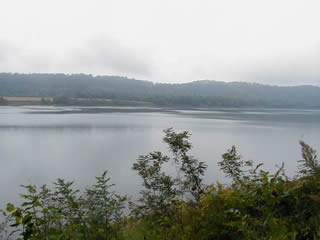|

Rivers
Indiana has nearly 36,000 miles of
rivers, which are an extremely important part of Indiana's past
and present. The major rivers in the state include the Ohio, Kankakee,
Wabash, White, and Tippecanoe.
Rivers were important in settlement
times because they were a major source of transportation for the
pioneers. They have also served as a travel route for aquatic and
terrestrial animals, as well as plant life, thus playing "a
key role in shaping the present distribution of much of the state’s
native flora and fauna” (Huffman 217).
An example of the importance of rivers
in Indiana is the Big River area, which helps form the southern
and part of the western state border. It is composed
of the Ohio River, the lower Wabash River, and the lower White
River. The Big Rivers’ aquatic environment is of “tremendous
size…with its own distinct assemblage of aquatic organisms” (Huffman
217). More fish, such as silvery minnows, channel catfish, and
white crappies, exist in the Big Rivers than in any other bodies
of water in the state. Furthermore, because of the steady current
in the main channels and slower, deeper pools, several rare fish
species, such as lake sturgeons, alligator gars, and skipjack herrings,
also survive there.
Typically, when ecologists and geologists
talk about rivers, they also talk about watersheds. Watersheds
refer to the entire landscape that drains its surface water into
a particular lake or stream. Indiana has thirty-nine major watersheds,
all of which are important when considering water quality in a
given area. If, for example, pesticide runoff contaminates one
tributary in a watershed area, the larger body of water it drains
into is also contaminated. Thus, the broader implications of water
pollution can be best understood by examining the drainage patterns
of water within a watershed.
Fortunately, efforts have been made
to improve the river water
quality, such as improved agricultural practices and better
wastewater treatments, but these rich ecosystems will probably
never regain the pristine quality of pre-settlement times.
Sources:
Huffman, Hank. "Waters in Motion:
The Big Rivers Natural Region." The Natural Heritage of
Indiana. Ed. Marion T. Jackson. Bloomington: Indiana UP, 1991.
217-22.
State of Indiana. Department of Environmental
Management. Office of Water Quality. "Executive Summary." Indiana
Integrated Water Quality Monitoring and Assessment Report 2002.
2002. 18 Nov. 2002 <www.in.gov/idem/water/planbr/wqs/quality/2002integrept/
execsumm.pdf>.
---. Department of Environmental Management.
Office of Water Quality. "Watersheds 101: Useful Things to
Know About Your Water Resources." Watershed Action Guide
for Indiana. 2002. 18 Nov. 2002 <www.in.gov/idem/water/planbr/wsm/chapter8.pdf>.
|




